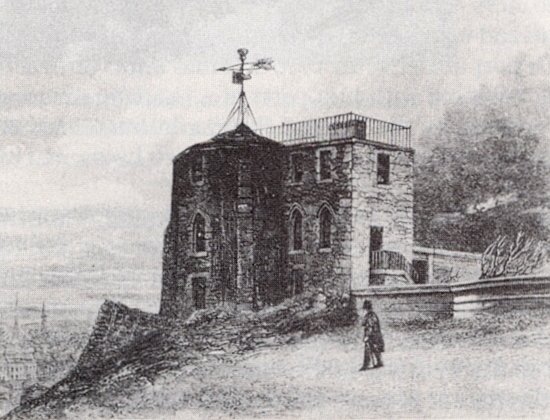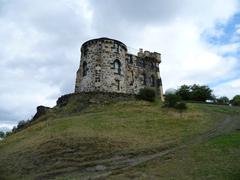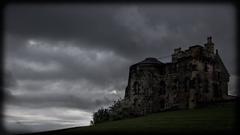
Visiting Observatory House, Calton Hill, Edinburgh: Guide, Tickets, Hours, and Tips
Date: 14/06/2025
Introduction
Observatory House, perched atop the iconic Calton Hill in Edinburgh, is a unique convergence of history, architecture, science, and contemporary art. As the oldest surviving building on Calton Hill, it embodies Edinburgh’s Enlightenment-era legacy, scientific ambition, and ongoing cultural innovation. Originally conceived in the late 18th century by optician Thomas Short and designed by New Town architect James Craig, Observatory House has transitioned from an astronomical hub to a heritage accommodation and contemporary art venue, thanks to meticulous restoration and adaptive reuse (The Scotsman; Collective Edinburgh).
This detailed guide provides practical visiting information, historical context, architectural highlights, tips for making the most of your visit, and answers to frequently asked questions. Whether you are an architecture enthusiast, art lover, or simply seeking Edinburgh’s best city views, Observatory House and Calton Hill offer a richly layered experience at the heart of Scotland’s capital.
Table of Contents
- Introduction
- History and Origins
- Architecture and Restoration
- Contemporary Role and Cultural Significance
- Visitor Information: Hours, Tickets, and Accessibility
- Accommodation and Booking
- Nearby Attractions and Tips
- Frequently Asked Questions (FAQ)
- Conclusion and Recommendations
- References
History and Origins
Observatory House’s story begins in the late 18th century, when Thomas Short, a renowned optician and instrument-maker, envisioned establishing an astronomical centre in Edinburgh. Short’s vision reflected the city’s Enlightenment ideals, aiming to foster scientific observation and public education (The Scotsman). James Craig, famed for his Edinburgh New Town masterplan, was commissioned to design the building.
Craig’s plans included a distinctive circular gothic tower, blending scientific functionality with late Georgian architectural style. Financial setbacks and differing visions (notably from rival architect Robert Adam) delayed the building’s completion and complicated its early years (Collective Edinburgh).
Through the 19th century, Observatory House alternated between astronomical observation and military use, at one point serving as a gunpowder store. In 1812, the Edinburgh Astronomical Institution revived its scientific purpose, and architect William Henry Playfair later added the adjacent City Observatory, cementing Calton Hill’s status as a centre for science and architectural grandeur (Edinburgh Architecture).
Architecture and Restoration
Observatory House exemplifies Georgian domestic architecture with its robust stonework, sash windows, and symmetrical design, crowned by a unique gothic tower. The building’s elevated position provides panoramic city vistas and practical conditions for astronomical study.
In the 20th century, the building fell into disuse and disrepair, eventually being listed as a Category A structure and placed on Scotland’s Buildings at Risk register. Rescue and restoration came in the 2000s, initially led by the Vivat Trust and later by the arts organisation Collective, with support from the Architectural Heritage Fund (AHF). The restoration preserved original features while introducing modern comforts and contemporary art, transforming Observatory House into heritage accommodation and an artist residency (Herald Scotland).
Notable interior features include the astronomer’s suite with a domed, artist-painted ceiling and the gothic tower’s dining room, adorned with commissioned art. This blend of history and contemporary creativity makes every visit distinctive and memorable.
Contemporary Role and Cultural Significance
Now managed by Collective, Observatory House is more than a preserved monument: it is part of an active cultural campus on Calton Hill, which also includes the City Observatory and City Dome (Collective Edinburgh). Collective’s programming brings together contemporary art, public engagement, and heritage interpretation, positioning the site as a living monument to Edinburgh’s Enlightenment legacy.
Observatory House’s role as art accommodation supports both cultural tourism and the arts, with rental income funding the preservation of the site. The building’s context within Calton Hill’s neoclassical ensemble (National Monument, Nelson Monument, Dugald Stewart Monument) further reinforces its symbolic status in Edinburgh’s “Athens of the North” identity (Edinburgh Architecture).
Visitor Information: Hours, Tickets, and Accessibility
Observatory House Access
- Accommodation: Observatory House is primarily available as a private self-catering holiday let. Bookings must be made in advance (Official Observatory House Website).
- Public Tours: The house is not generally open for public tours or drop-in visits. Some public events or artist residencies may offer limited access; check Collective Edinburgh for updates.
Calton Hill and Surrounding Monuments
- Calton Hill Grounds: Open year-round, 24/7, with free access. Enjoy panoramic views, walking paths, and historic monuments.
- Nelson Monument: Open seasonally, typically 10:00 AM–5:00 PM. Tickets available on-site or online.
- City Observatory & Dome (Collective): Open Wednesday–Sunday, 11:00 AM–5:00 PM (last admission 4:30 PM). Hours may vary; check the Collective website before visiting.
Accessibility
- Calton Hill: Accessible on foot via stairways and paths from Princes Street or Royal Terrace. Moderate ascent; not suitable for all mobility levels.
- Observatory House: Due to its historic design (stairs, no lift), limited wheelchair accessibility. The City Observatory site is adapted for wheelchair access.
- Facilities: Public restrooms near the hill’s entrance; café and gift shop available within the Collective campus.
Getting There
- By Foot: 5–10 minutes’ walk from Edinburgh city centre (Princes Street, Waverley Station).
- By Public Transport: Multiple Lothian Buses routes stop nearby.
- By Car: Drop-off via the summit access road; no visitor parking on-site.
Accommodation and Booking
- Observatory House: Sleeps up to 4 (main house) or 6 (with apartment). Features include the astronomer’s suite, contemporary kitchen, private garden, and original architectural details.
- Booking: Managed by Collective and Stay Altido. Reserve via Stay Altido, email ([email protected]), or phone (+44 (0)131 510 8567).
- Rental Terms: Minimum 2–3 night stay; no pets; event hire possible for weddings or private functions (Edinburgh Guide).
- Accessibility: Not recommended for guests with significant mobility issues.
Nearby Attractions and Tips
- Monuments: National Monument, Nelson Monument, Dugald Stewart Monument, and City Observatory—all within walking distance on Calton Hill.
- Café Calton: Opened June 2025, offering Scottish-inspired food and drinks with terrace seating (Café Calton).
- Photography: Best light at sunrise or sunset; exceptional city panoramas.
- Events: Beltane Fire Festival (April 30), Edinburgh Festival Fireworks (August), Hogmanay celebrations.
- Weather: Edinburgh is known for changeable weather—bring layers, rain jacket, and sturdy shoes.
- Accessibility Tip: Calton Hill’s main ascent is moderate but may be challenging for some. Use the Regent Road stairs or Royal Terrace route for gentler access.
Frequently Asked Questions (FAQ)
Q: Can I visit Observatory House without booking accommodation?
A: No. The house is a private rental and not open for casual visits. The surrounding Calton Hill grounds and monuments are open to all.
Q: What are the visiting hours for Calton Hill?
A: Calton Hill is open 24 hours daily. Monuments like the Nelson Monument have specific hours (typically 10:00 AM–5:00 PM).
Q: Are guided tours available?
A: There are no official tours of Observatory House, but several operators offer guided walks of Calton Hill and its monuments.
Q: Is Observatory House wheelchair accessible?
A: The house is not wheelchair-friendly due to stairs; the City Observatory site is more accessible.
Q: Is parking available on Calton Hill?
A: There is no visitor parking at the summit. Use public transport or city centre parking.
Conclusion and Recommendations
Observatory House is a rare gem in Edinburgh’s cultural landscape—its rich heritage, architectural charm, and breathtaking views make it a highlight for those seeking a deeper connection to the city’s past and present. While public access is limited to accommodation bookings and special events, the wider Calton Hill site is open year-round and offers an array of historic monuments, artistic experiences, and iconic city vistas.
For the best experience:
- Book your stay at Observatory House well in advance, especially during festival seasons.
- Plan your visit during spring or summer for optimal weather and longer daylight.
- Explore nearby monuments and enjoy events hosted by Collective.
- Download the Audiala app for curated travel tips, event updates, and exclusive deals.
- Follow Collective and Edinburgh travel sites for the latest news on exhibitions and special access opportunities.
Immerse yourself in the spirit of Edinburgh’s “Athens of the North” and make Observatory House a memorable part of your visit.
References
- Observatory House Edinburgh: History, Architecture, Visitor Info & Cultural Significance (The Scotsman)
- Architectural and Cultural Significance (Herald Scotland)
- Observatory House Edinburgh Visiting Hours, Tickets & Insider Tips (Official Observatory House Website)
- Visitor Tips at Observatory House on Calton Hill (TravelSetu)
- Architectural Heritage and Edinburgh Architecture (Edinburgh Architecture)
- Restoration and Contemporary Significance (AHF)
- Collective Edinburgh (Collective Edinburgh)
- Discover Observatory House (Truly Edinburgh)
- Café Calton (Café Calton)
- Edinburgh Guide (Edinburgh Guide)




















































































